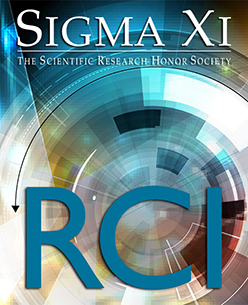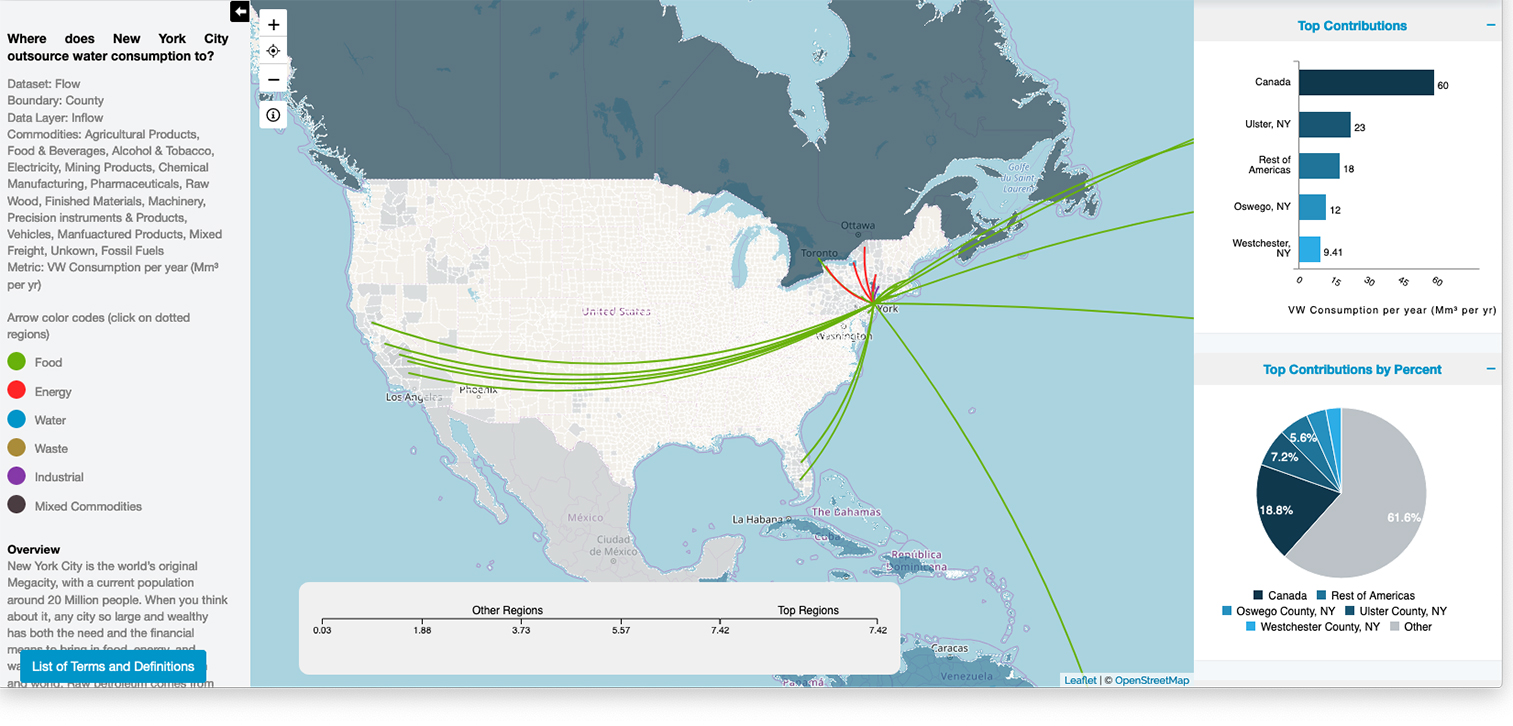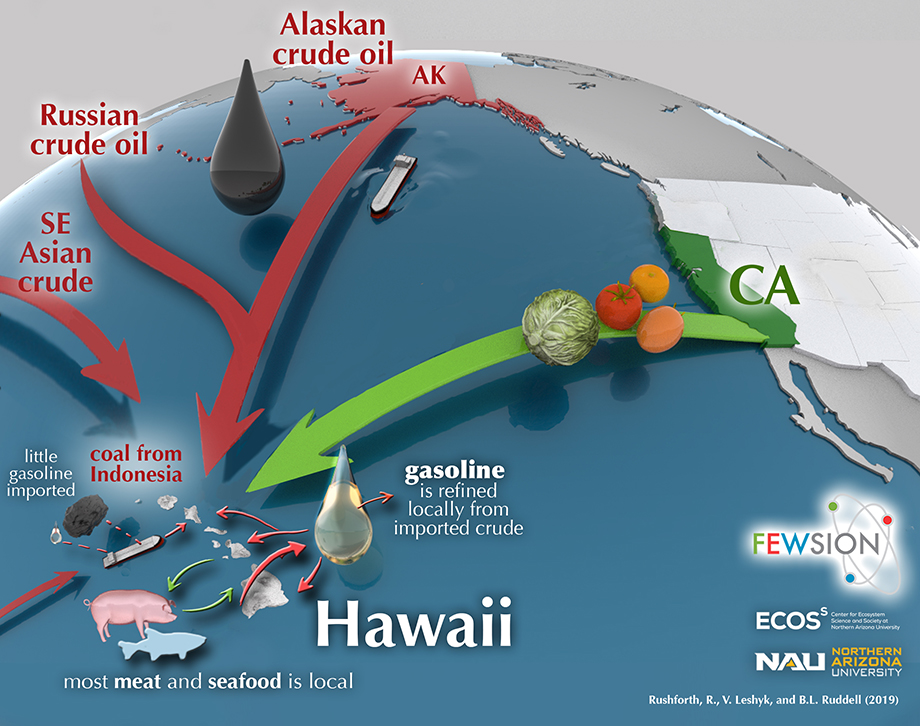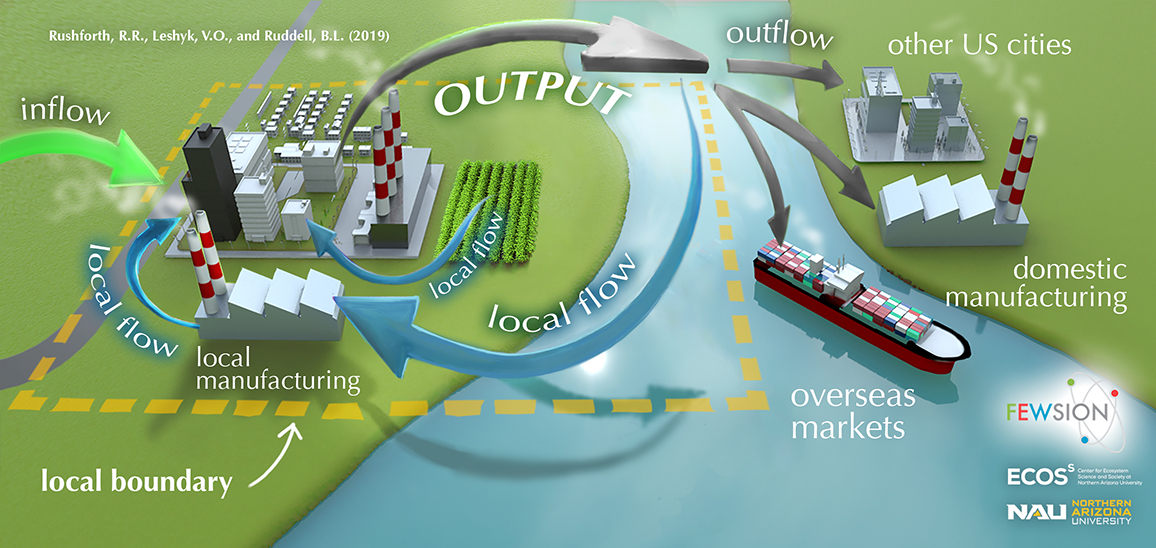Do You Know Where your Food, Energy, and Water Come From?
By Victor O. Leshyk, Benjamin L. Ruddell, Richard R. Rushforth
A new data visualization tool shows you your connections.
April 29, 2019
Macroscope Agriculture Policy Technology Geographical Distribution Human Ecology

This blog post is a part of Sigma Xi's
Research Communications Initiative.
Food isn’t grown in the grocery store, water isn’t formed in your tap when you turn it on, and electricity isn’t made in your wall socket—but beyond looking at a few product labels, how much do we really think about where our critical resources come from? Part of the difficulty is that the path from supplier to consumer can be so convoluted that it’s overwhelming for the average person to figure out the route. So in our new research project, we’re mapping out the resources’ journey for every local region in the United States, and that will help to make these systems more accessible and resilient.
What ties together food, energy, and water—referred to collectively as FEW systems—is that they are critical resources: We cannot live without them, and they must be affordable and reliable for everyone, everywhere. It’s not overstating to say that without these systems, modern civilization would not have been established. But the flip side of this critical need is that food, energy, and water production are responsible for the majority of humanity’s “footprint” on the planet, and they therefore are a key sustainability challenge for the 21st century.

Rushforth, R.R., Leshyk, V.O., and Ruddell, B.L. (2019), Where does New York City outsource water consumption to? 29 April 2019.
Your food, energy, and water consumption connects you across the globe to distant ecosystems, through vast networks of production and transportation that are called supply chains. These supply chains have grown piece-by-piece—sometimes planned, sometimes not—into our current global network. Supply chains cross over political boundaries, mountain ranges, and oceans, making us interdependent on one another. And in our modern supply chains, events in one area—from weather disasters to individual buying decisions—can have a butterfly effect on the system as a whole, and often in unexpected ways.
FEW systems form an interdependent triangle, creating a nexus that connects policy decisions, consumer choice, land use, emergency management, and environmental resources. This connectivity means that nearly everyone alive today, no matter how remote, is part of the same network of connecting FEW systems. For instance, a large portion of the Earth’s freshwater is withdrawn to irrigate crops or produce electrical power. But the provision of potable water requires copious amounts of electrical power to pump, treat, and distribute water. In addition, biofuels (produced from crop byproducts) increasingly power our cars, trucks, and trains. But vast amounts of energy are also used to produce fertilizers to help grow our food. So the production and use of food, energy, and water is interconnected along many paths. And at the nexus where these networks connect, both efficiency and waste can be amplified with a “feedback” effect. For instance, electrical energy efficiency can reduce the demand for water to produce power, freeing that water for food production or habitat conservation for freshwater fish. On the other hand, for example, making a switch to biofuels might save energy, but cost more water for production. Therefore, decisions made that can affect FEW systems at a nexus need special consideration; they could have maximum impact there, but possibly also unforeseen side effects.

Rushforth, R.R., Leshyk, V.O., and Ruddell, B.L. (2019), Where are Hawaii's food and energy dependencies? 29 April 2019.
What is your unique place in the global FEW system? Do you know where your food, energy, and water come from? Is your hometown vulnerable to a drought or disaster on the other side of the country or across an ocean? Do you understand how your choices might cause or prevent environmental degradation? What is your water and carbon footprint? Your FEW system is complex, and thus difficult to observe, describe, and visualize.
In our modern supply chains, events in one area—from weather disasters to individual buying decisions—can have a butterfly effect on the system as a whole, and often in unexpected ways.
Answering these questions requires a vast set of data to be collected and organized into a useful format. That is the goal of the FEWSION™ project, led by Dr. Benjamin Ruddell at Northern Arizona University, with support from the National Science Foundation and U.S. Department of Agriculture, along with a team of researchers from several universities. The research team is building a first-of-its-kind visualization tool that maps the U.S. FEW systems. The system is now available for free to teachers, emergency managers, students, scientists, and community leaders. The FEW-View™ system can show you the FEW supply chains of your industry, city, or state, and can help you understand your footprints, local sourcing, resilience, and vulnerability. The visualization system is based on a database that fuses together terabytes of multiple datasets collected by both federal agencies and scientists, to create a more complete picture of the FEW systems.
To introduce new users, FEW-View™ will first show you several established scenarios, including New York City’s water dependence on widespread areas of the United States, Hawaii’s long-distance supply chains for produce and energy sources, and a general example of local food supply between two cities (shown above). Other examples you can see include Hurricane Harvey’s effects on gasoline supply chains, the effect of a catastrophic earthquake in Los Angeles, the impact of a catastrophic Cascadian earthquake and tsunami off the coast of Seattle and Portland, examples of how drought can create risk in supply chains, and several other scenarios. After walking through a scenario, users can build their own scenarios and map their own FEW systems.

Rushforth, R.R., Leshyk, V.O., and Ruddell, B.L. (2019), What states have the most local food industries? 29 April 2019.
More educational resources are available on the FEWSION™ website. Check out the latest episodes of Crucial FEWSION, an audio podcast on FEW systems, or CodeBlue, a video documentary series exploring FEW system issues in each U.S. state. A catalog of links to other national education resources is provided. Finally, you can find out how to launch a FEWSION™ for Community Resilience (F4R) project in your neighborhood or at your university to map, understand, and take action on the “last mile” of your supply chains.
Acknowledgements
FEWSION™ was founded in 2016 by a grant from the INFEWS program that is sponsored by the National Science Foundation (NSF) and the U.S. Department of Agriculture (USDA), #ACI-1639529. The opinions expressed are those of the researchers, and not necessarily the funding agencies.
This blog post is a part of Sigma Xi's Research Communications Initiative.
American Scientist Comments and Discussion
To discuss our articles or comment on them, please share them and tag American Scientist on social media platforms. Here are links to our profiles on Twitter, Facebook, and LinkedIn.
If we re-share your post, we will moderate comments/discussion following our comments policy.